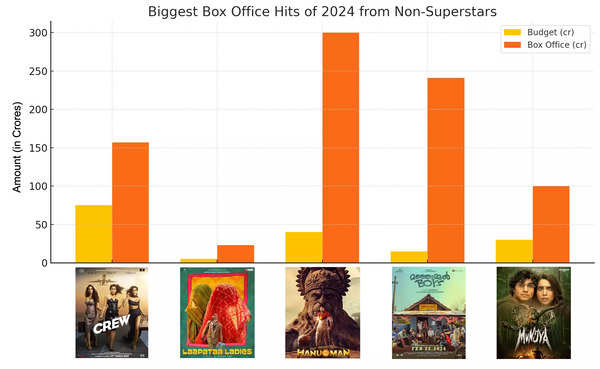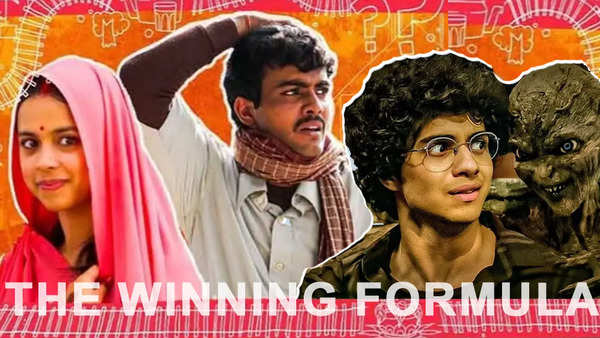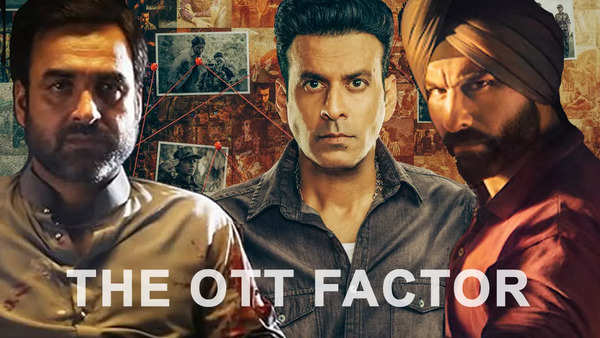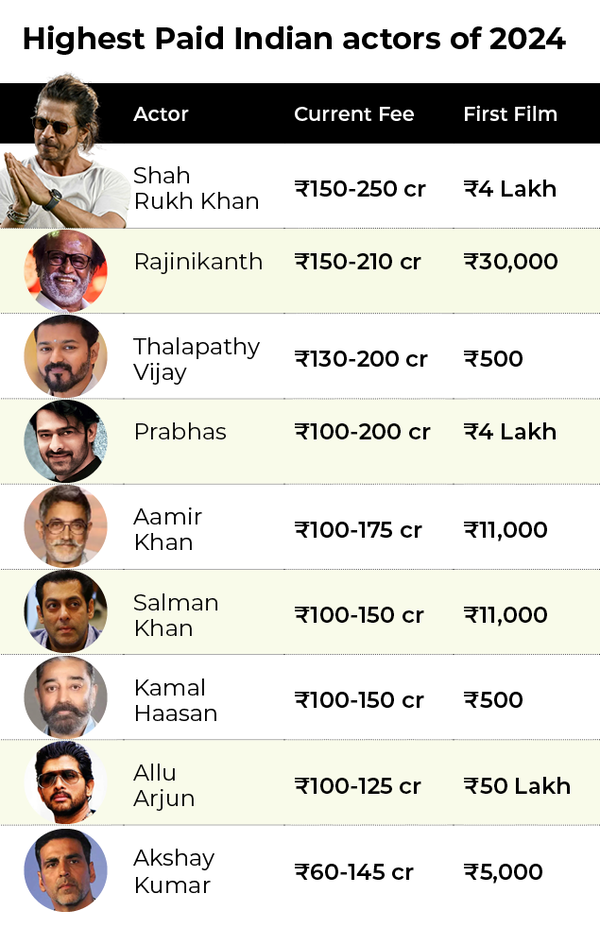rewrite this content and keep HTML tags
At a time when films like Nag Ashwin’s ‘Kalki 2898 AD’ with its ensemble star cast including Prabhas, Deepika Padukone and Amitabh Bachchan is ruling the box office, a parallel branch of cinema is emerging where films without any major celebrity or inflated budgets are making significant strides at the box office.
Devoid of celebrity clout, movies like ‘Laapata Ladies’, ‘Hanu Man‘, ‘Manjummel Boys’, and ‘Munjya’ have not only captured the audience’s attention but have also become blockbuster hits. This changing dynamic prompts a deeper examination of the ever-evolving star value, the influence they hold and the changing equations that make a film a blockbuster in today’s cinematic landscape.
Biggest Office Hits Of 2024 From Non-Superstar Films

Here’s a graph illustrating the biggest box office hits of 2024 from non-superstar films. The graph compares the budgets and box office collections for ‘Crew’, ‘Laapataa Ladies’, ‘Hanu Man’, ‘Manjummel Boys’, and ‘Munjya’.
Crew: Starring Kareena Kapoor Khan, Tabu and Kriti Sanon, the film was made on a budget of Rs 75 crore and earned a total box office collection of Rs 157 crore.
Laapataa Ladies: The film starring Nitanshi Goel, Pratibha Ranta, and Sparsh Shrivastava in lead roles was made on a budget of Rs 5 crore and went on to earn Rs 23 crore at the box office.
Hanu Man: A Telugu-language superhero film starring Teja Sajja in the lead, was made on a budget of around Rs 40 crore, and emerged as one of the biggest box office hits with a collection of over Rs 300 crore.
Manjummel Boys: The Telugu film, based on a true story stars Soubin Shahir, Sreenath Bhasi, Balu Varghese, and Ganapathi S. Poduval and was made on a budget of Rs 15 crore. The film went on to earn a box office collection of Rs 241 crore.
Munjya: Mad on a budget of Rs 30 crore, the film starring Abhay Verma and Sharvari, scored a box office collection of an estimated Rs 100 crore.
This graph visually represents how these non-superstar movies have achieved remarkable success despite their modest budgets, further highlighting the shifting dynamics in Bollywood’s star value.
Fading Star Power

As Bollywood grapples with this surprising twist of non-celebrity movies emerging as blockbuster hits, this phenomenon prompted a reevaluation of what truly draws audiences to theatres.
Renowned filmmaker Mukesh Bhatt acknowledges this shift, stating, “No, star value is still there. But now, more than the star value, people are asking for something different. That was an old box office formula for Bollywood. People are sick and tired of that.”
This sentiment is echoed by film exhibitor Akshaye Rathi, who highlights the recent successes of movies like Vidhu Vinod Chopra’s “12th Fail,” Aamir Khan‘s “Laapata Ladies,” and Dinesh Vijan’s “Manjaya.” Rathi observes, “The star of these films were the stories and the storytellers and I really think that a star is only the booster, but the ship that sails is ultimately great storytelling. I think the audience has given us enough and more occasions where they have turned up for great storytelling and not turned up despite the presence of a star in a film. That is something we need to take cognizance of as an industry.”
Actress Nitanshi Goel, starred in the box office hit ‘Laapataa Ladies’ and also starred in the Ajay Devgn’s Rs 100 crore movie ‘Maidaan’ which failed to make a mark at the ticket windows. Reflecting on the evolving preferences of moviegoers and the success of the horror-comedy ‘Munjya’, she notes, “Munjya has been performing exceptionally well. Abhay Verma and I have often discussed how significant this is for us. We always dreamed that our films would be loved by the audience and that we would be recognised as leading actors. At the same time, it seems that people are now more interested in characters than the stars.”
The stars of these small budget films were the stories and the storytellers
Akshaye Rathi
The Winning Formula

There’s no denying that 2024 has witnessed a remarkable trend that sees smaller-budget movies achieving unprecedented success at the box office. Although lacking the glitz and glamour of high-profile stars, these movies have captivated the audience’s attention with their compelling storytelling. When probed with the question of why these modest productions have resonated so profoundly with viewers, Nitanshi says, the answer lies in the quality of the content, while veteran producer Mukesh prefers to wait and observe.
Nitanshi, reflecting on the success of her film ‘Laapataa Ladies’, emphasises, “Content comes first. If content is made well, the audience cannot say no to love. Beautiful stories and lovely characters are opening doors for newcomers like us, and I finally feel like we can perform and become next-gen Bollywood actors.”
The film industry is in the business of making flop pictures… You can never plan a hit, but you can minimize your losses.
Mukesh Bhatt
Bhatt, on the other hand, drew a parallel between the unexpected success of ‘Munjya’ and the iconic ‘Jai Santoshi Maa’, a film that stood out as a hit amidst a long list of it’s sequels failing at the box office. “Why it worked, nobody knows, not even Anil Sharma who made it. That is the beauty of this business. You don’t know what the audience wants. You think they’ll like this, but you don’t know. The film industry is in the business of making flop pictures. Sometimes the producer is lucky to stumble upon a hit. You can never plan a hit, but you can minimise your losses.”
Raj Bansal, an exhibitor and distributor, says, “Each year, 2-3 small-budget films achieve record business, but these are just a few out of over 100 films produced. Examples include ‘The Kashmir Files,’ ‘The Kerala Story,’ ‘Article 370,’ ‘Laapata Ladies,’ and the latest, ‘Munjya.’ These days, many Hindi films fail due to the very high fees of lead actors. Actor’s fees should align with the film’s success or failure. We must focus on creating quality music and scripts to ensure overall success.”
The OTT Factor

It’s impossible to overlook the role OTT plays in reshaping viewing habits and redefining the very fabric of cinematic storytelling. These streaming platforms have silently been influencing the audience’s preferences and perceptions of films, ultimately setting new benchmarks for what constitutes compelling entertainment.
Highlights how OTT platforms have disrupted this status quo by offering a diverse array of content previously inaccessible through mainstream channels, Be notes, “The new generation has come, and they’re asking for more. OTT has exposed them to different kinds of content.”
He adds, “I’m not saying OTT is the answer, but, it has shown them content which was not available on TV serials and in movies. That is why OTT grew – out of the need of man to have some kind of a variety.”
Think Small
In a bid to explore what drives the success and appeal of smaller films, Nitanshi says it is the magnetism of ‘simple, relatable’ narratives that have the biggest pull. However, Bhatt, on the other hand, emphasizes practicality and fiscal discipline as key factors.
The actress, said, “I feel that audiences always want such simple, relatable stories, and when they see it, they immediately give you a lot of love.”
Bhatt, got down to the number game, saying, “They spend where they need to spend. That’s all. You have to spend in what you can see on the screen. Anything that you spend on, which is outside the screen is a waste of money.”
Economics Of The Film Industry

The landscape of contemporary Indian filmmaking is shaped by a complex interplay of economics, creativity, and evolving audience dynamics. There is a growing concern over the effectiveness of star-driven strategies amidst escalating fees, inflated budgets and rising production costs which remain indifferent to a film’s success or failure, prompting many to question the sustainability of this model. Bhatt, reflecting on these challenges, advocates for a pragmatic shift back to the profit-sharing mechanisms of 2015, before the disruptive influence of OTT platforms. He argues, “If the film is a hit, then share in the profit. Let the film earn. You also get a reputation that you have given a successful film. That also works for the director, producer, and everybody else. It is a simple thing, but people don’t want to go down. It doesn’t suit them.”
Critiquing agencies handling stars, fixated on maximizing their own earnings, he says, “The agencies who are running the stars, they are very corrupt. Because they are only interested in their 10% (cut).”
An actor’s fees should align with the film’s success or failure
Raj Bansal
In contrast, film exhibitor Akshaye Rathi emphasizes the pivotal role of storytelling innovation and audience engagement in achieving substantial box office success. He contends, “For those Rs 200, 300, 400 crores to happen at the box office we need stars to drive these vehicles, but ultimately it has to be some novelty and uniqueness, excitement and storytelling. Only once we can do that with a certain consistency in a manner that it intrigues and captures the imagination of the widest possible audience not just an urban niche, but also the common man, will we be able to deliver the big numbers.”
The whole system has gone corrupt
Mukesh Bhatt
The Way Forward
As the industry evolves and learns to adapt to the changing audience preferences and economic realities, Bhatt also suggests an urgency for stars and industry professionals alike to reassess the financial demands, that he claims, have led to a systemic corruption, jeopardizing the sustainability of film projects. Bhatt says, “The correction has to happen. Any star who will not understand that times have changed will perish. By stars, I also mean any technician, director, writer, or cameraman, the whole system has gone corrupt. You need to come to a real understanding of the real cost of a film and not the inflated, flabby budget films. They are going to fail.”
Pratibha Ranta, Nitanshi Goel and other ‘Laapataa Ladies’ cast on working with Kiran Rao and Aamir Khan

